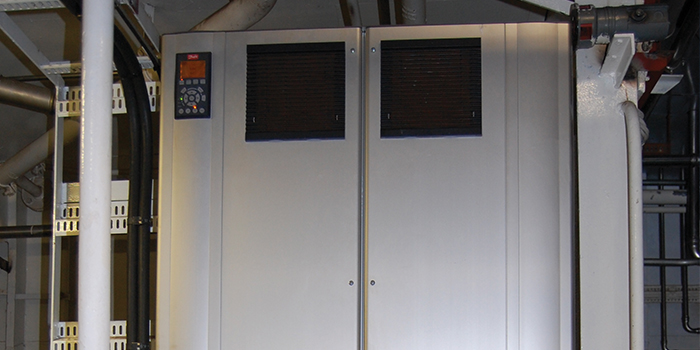 MV SIA is the newest cable-laying vessel from CT Offshore, located in Odense, Denmark. CT Offshore specialises in installing and maintaining offshore cables for the many new wind turbine farms that will deliver environmentally friendly energy in the years to come.
MV SIA is the newest cable-laying vessel from CT Offshore, located in Odense, Denmark. CT Offshore specialises in installing and maintaining offshore cables for the many new wind turbine farms that will deliver environmentally friendly energy in the years to come.
— THURSDAY, 24 JULY 2014 BY DANFOSS POWER ELECTRONICS A/S
VLT® High Power frequency converters strengthen the ship’s tunnel thrusters, while active harmonic filters provide high voltage quality for the vessel’s 3.2 MW generator. CT Offshore has converted an outdated ferry from 1978 into a cutting-edge cable-laying vessel with all the latest equipment for installing and maintaining cables between off shore wind turbines and the electricity network on shore.The entire ship has undergone a full refurbishment in which all the installations have been renovated, and a good deal of special equipment has been installed to handle the cable work. There are a total of 47 cabins where the ship’s crew and the client’s wind turbine experts can live and work under comfortable conditions.
To hold the SIA in position with a precision of 200 mm the Dutch Thruster Group supplied 7 GME e-motor driven 200kW tunnel thrusters in the bow (4) and stern (3). Together with an existing thruster of 400kW the combined power of 1.8 MW in full integration with a Navis dynamic positioning system navigates the vessel along the preprogrammed route – even under the difficult weather conditions and strong currents that often plague the North Sea. To provide power to the thrusters and other equipment, the Dutch Thruster Group also supplied a power plant of 3.2 MW, consisting of four Mitsubishi diesel generators and two 190A VLT Advanced Active Filters.
The Dutch Thruster Group decided to speed-regulate the thrusters using Danfoss frequency converters, instead Danfoss frequency converters, instead of a traditional solution with a fixed speed e-motor and variable pitch propeller or a hydraulic driven system. “We chose a frequency converter driven system because it is economically attractive, fuel efficient and maintenance free. With additional moving parts for pitch control or a hydraulic system, more maintenance would be the result,” explains Martin Franken, manager Sales & Marketing, Dutch Thruster Group.
“For a vessel operating around the clock under dynamic positioning a controllable pitch system with the e-motors running at full speed over a longer period of time at low load would waste a lot of energy. A frequency converter on the other hand can adjust exactly to the power needed without compromising the efficiency. Compared to hydraulic thruster systems a staggering 20% power is saved on system losses,” adds General Manager and Project Leader, Edy Vos, from the Dutch Thruster Group.
The ship is classified under Lloyd’s Register of Shipping for dynamic positioning in accordance with DP 2. This DP2 classification means that there is a redundancy on all active systems, preventing simple errors leading to hazardous situations which can result in loss of positioning power.

The generator unit can be divided into two independent systems of 1.6 MW when SIA operates in DP2 mode. The two active harmonic filters on the starboard and port sides ensure that harmonic voltage distortion is lower than 8% THvD, in accordance with Lloyd’s Register of Shipping’s rules – even when all systems are simultaneously running at full power.
If the electrical supply had been installed without active filters, the generators would have to have been much larger to meet Lloyd’s requirements for voltage quality. This would have been a very expensive solution, and there was no room for larger generators in the existing engine room.
Plenty of excess powerSIA was commissioned in June 2010 following its refurbishment. The vessel proved to be completely stable during its seaworthiness testing – even when it turned quickly around with the thrusters running at full power. The ship’s crew are quite happy to work on the new ship. Ship’s mates Jan Eliassen and Milos Kos commented: “The first jobs were completed ahead of schedule – and we haven’t even had to use the ship’s full capacity. It’s nice to know that there’s more than enough power to tackle tougher jobs.”
